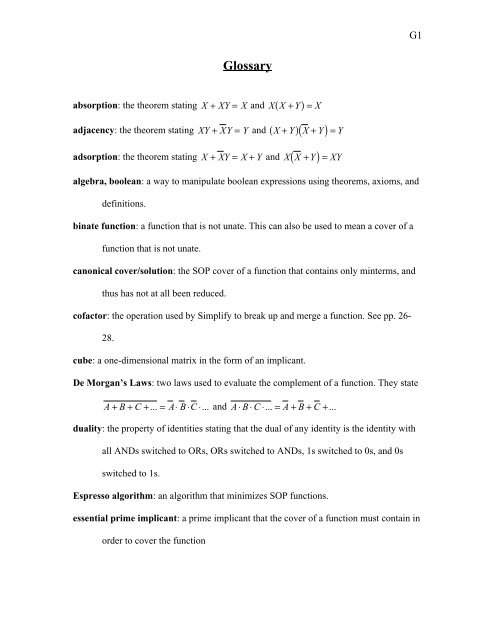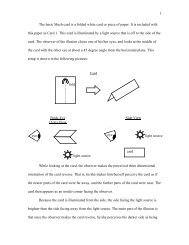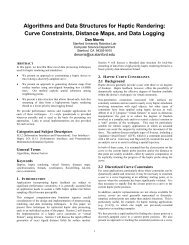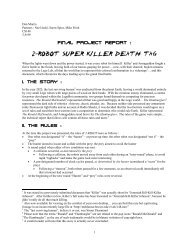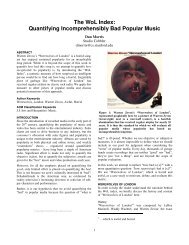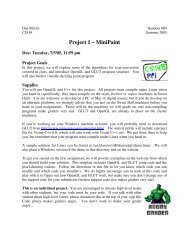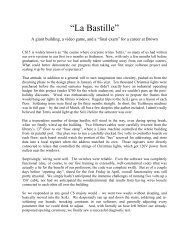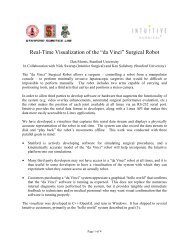Glossary (PDF)
Glossary (PDF)
Glossary (PDF)
Create successful ePaper yourself
Turn your PDF publications into a flip-book with our unique Google optimized e-Paper software.
<strong>Glossary</strong><br />
absorption: the theorem stating X + XY = X and X( X +Y ) = X<br />
adjacency: the theorem stating XY + XY = Y and ( X + Y)<br />
( X + Y)<br />
= Y<br />
adsorption: the theorem stating X + XY = X + Y and X( X +Y ) = XY<br />
algebra, boolean: a way to manipulate boolean expressions using theorems, axioms, and<br />
definitions.<br />
binate function: a function that is not unate. This can also be used to mean a cover of a<br />
function that is not unate.<br />
canonical cover/solution: the SOP cover of a function that contains only minterms, and<br />
thus has not at all been reduced.<br />
cofactor: the operation used by Simplify to break up and merge a function. See pp. 26-<br />
28.<br />
cube: a one-dimensional matrix in the form of an implicant.<br />
De Morgan’s Laws: two laws used to evaluate the complement of a function. They state<br />
A + B + C +... = A⋅ B ⋅C ⋅... and A ⋅ B ⋅ C ⋅... = A + B + C +...<br />
duality: the property of identities stating that the dual of any identity is the identity with<br />
all ANDs switched to ORs, ORs switched to ANDs, 1s switched to 0s, and 0s<br />
switched to 1s.<br />
Espresso algorithm: an algorithm that minimizes SOP functions.<br />
essential prime implicant: a prime implicant that the cover of a function must contain in<br />
order to cover the function<br />
G1
function, boolean: a function that takes boolean variables as inputs and creates a boolean<br />
output dependant on the inputs<br />
implicant: an ANDed string of literals. It is a term in an SOP function.<br />
Karnaugh map (K-map): a graphical representation of a function that makes it easy to<br />
apply adjacency<br />
Law of Consensus: the theorem stating AB + AC + BC = AB + AC . It is used to eliminate<br />
implicants in a Karnaugh map.<br />
literal: an instance of a boolean variable. It may be the variable complemented,<br />
uncomplemented, or ignored (don’t-care). In matrix representations or the Q-M<br />
algorithm, it may have a value of 0, 1, or 2/X, corresponding to complemented,<br />
uncomplemented, and don’t-care, respectively.<br />
matrix representation of a function or implicant: The rows of a two-dimensional<br />
matrix representation of a function are the implicants of the function. The<br />
columns of a one-dimensional matrix representation of an implicant are the<br />
literals of the implicant.<br />
minterm: an implicant that contains exactly one literal for each variable. It is not at all<br />
simplified.<br />
monotone decreasing: A function is monotone decreasing in a variable if changing the<br />
value of the variable from 0 to 1 results in the output of the function being 0.<br />
monotone increasing: A function is monotone increasing in a variable if changing the<br />
value of the variable from 0 to 1 results in the output of the function being 1.<br />
prime implicant: an implicant that cannot be further reduced by adjacency<br />
G2
primitive function: a function that takes one or two parameters and returns one output.<br />
The most common primitive functions are NOT, AND, OR, XOR, NAND, NOR,<br />
and XNOR.<br />
Quine-McCluskey (Q-M) algorithms: two algorithms that minimize a boolean function.<br />
The first algorithm finds all prime implicants, and the second algorithm eliminates<br />
nonessential prime implicants.<br />
Shannon’s Expansion Theorem: the theorem stating<br />
f ( x1 , x2 ,...,xn)= x1⋅ f( 1, x 2 ,..., xn ) + x1 ⋅ f ( 0, x2 ,...,xn). It also has another, logically<br />
equivalent form that can only be applied to SOP functions: f = xi fx i + xi f . It is xi used, among other things, to break up and merge a function in the Simplify<br />
algorithm.<br />
Simplify algorithm: an algorithm that minimizes a boolean function. It does this by<br />
recursively breaking up a function with Shannon’s Expansion Theorem until it is<br />
easy to simplify.<br />
sum of products (SOP): a form of a function consisting of two levels of operations:<br />
First, combinations of literals are ANDed together, forming terms. Then, these<br />
terms are ORed together. All boolean functions can be expressed as SOP<br />
functions.<br />
unate function: a function that is either monotone increasing or monotone decreasing in<br />
all of its variables.<br />
variable, boolean: a variable that can be in one of two states: 0 or 1.<br />
G3


